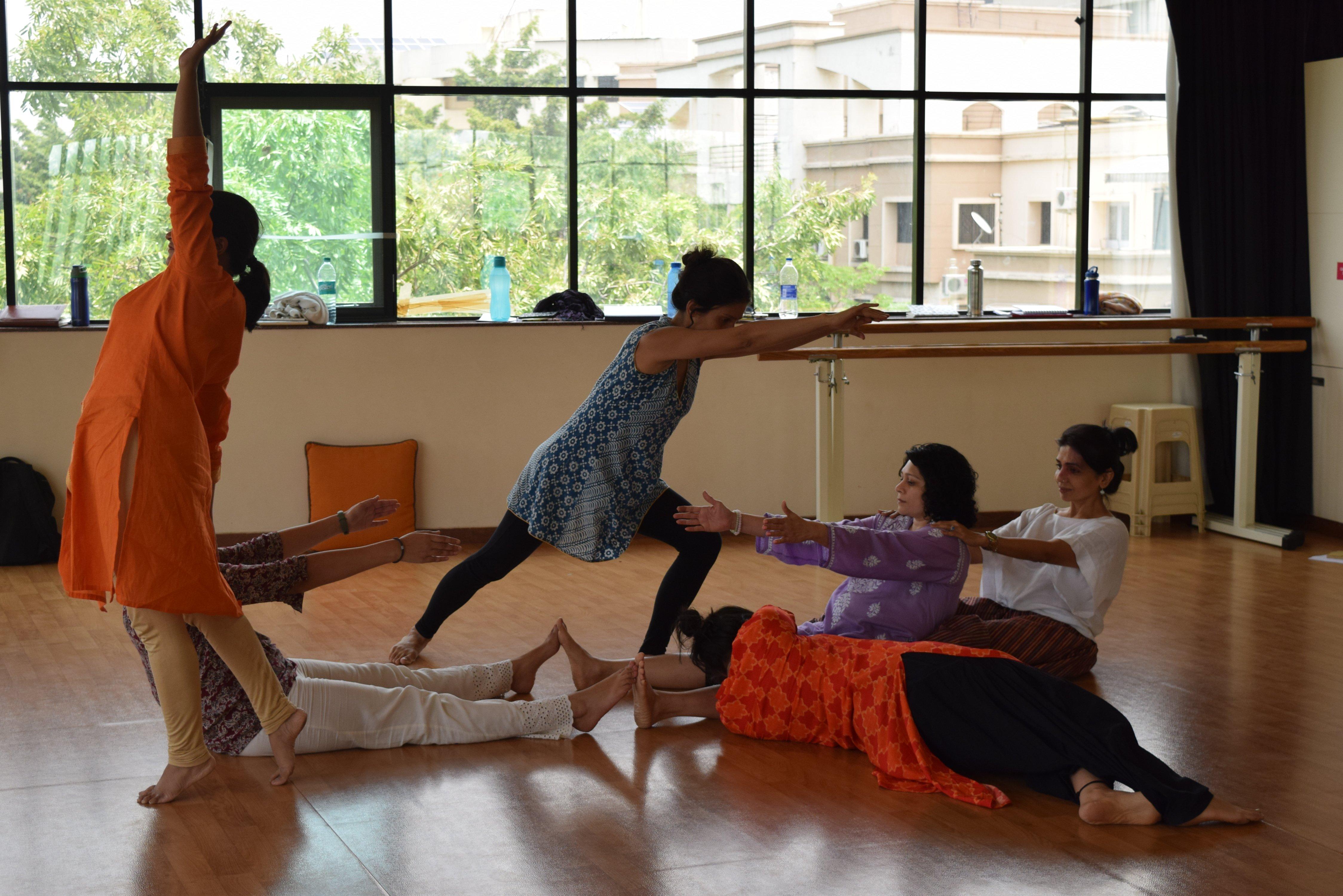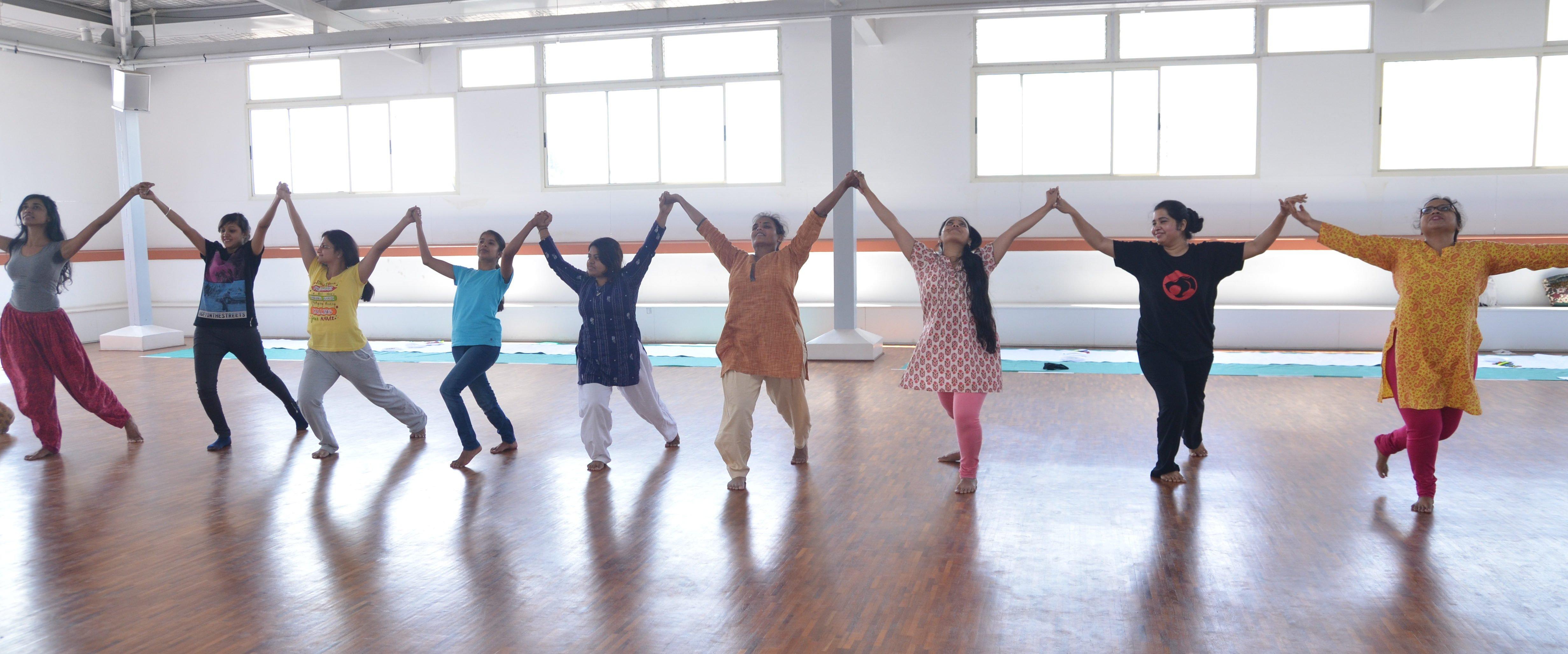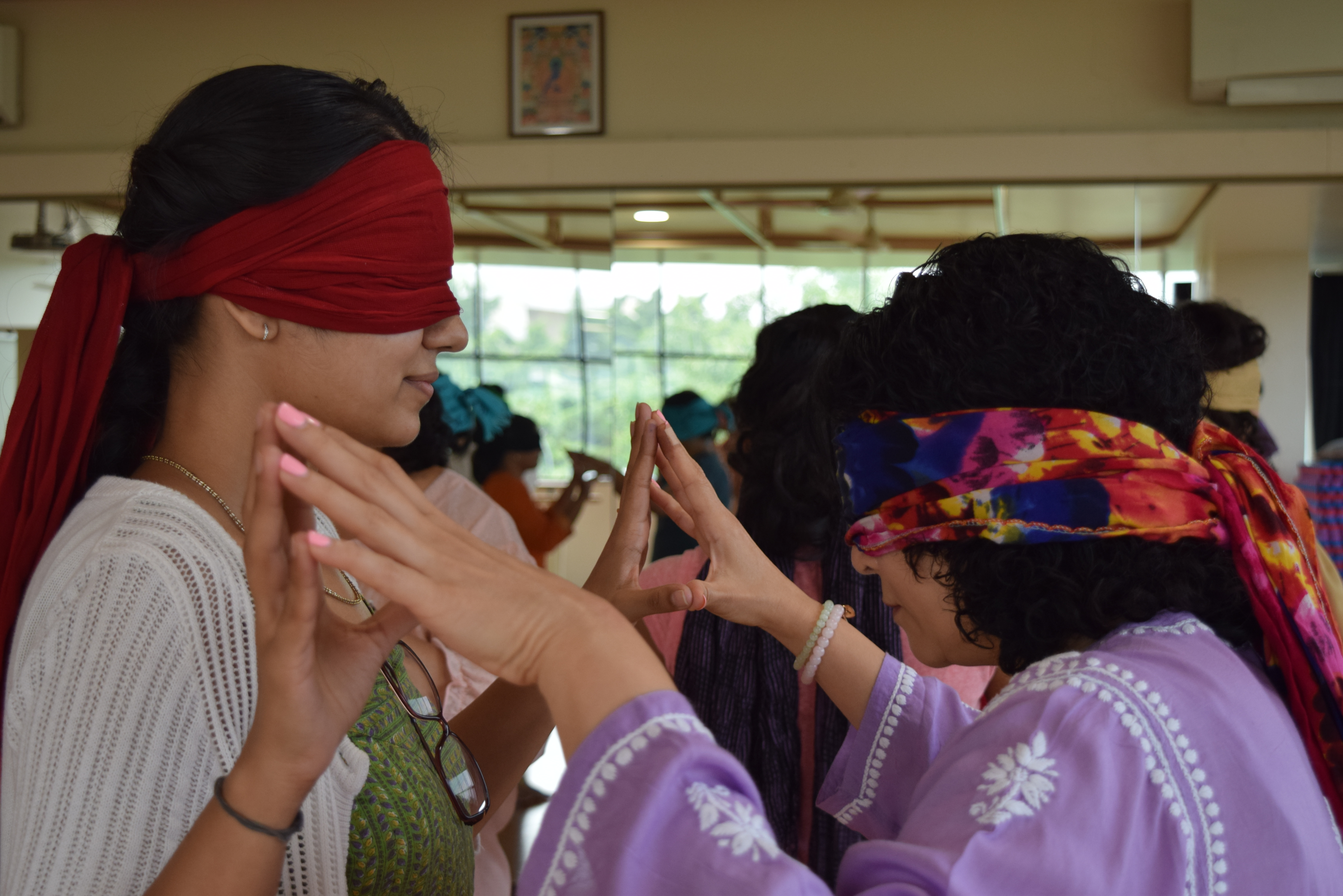Moving the Body’s Habits
A conversations with Tripura Kashyap, Dancer, Choreographer, Creative Movement Therapist (Part 1)
Shivani: Thank you for agreeing to be a part of the first issue of INTER-ACTONS themed BODY. Your Movement Therapy workshops are well known, especially with respect to developing a language for the body. Could you explain your practice and how you have developed it?
Tripura Kashyap: I like to call it Creative Movement Therapy, and in fact our organisation is called Creative Movement Therapy Association of India. We began it in Delhi in 2014. Movement therapy is basically, I would say, like body psychotherapy. When you’re troubled in your mind you go to a psychotherapist, you work out your thoughts and feelings. But here you are addressing the body. Through the body you are doing a lot of movement activities and games to help people express repressed emotions, feelings, something they are not able to articulate. Movement therapy is used in all these different kinds of contexts where people basically have a disturbed body-mind connection.

For me, personally, authenticity of a body or feeling comes out more through creative movement. It’s not about the deconstruction of any classical codified dance forms. It’s more about body movements, which are the alphabets of all types of dance forms. For example, I tell people, the space is divided into three levels. Can you move fluidly through these different levels in space? Or the space is divided into directions – front, back, side, etc. Can you move in these different directions? For me, I like working more on movement principles of all these dances, where I’m looking at this personal movement language that has nothing to do with a style or a form being teased out of the body. It’s almost like a formless dance. It’s really that person’s natural movement pattern. In fact when dancers walk into my workshop, they are so conditioned. If it’s a modern dancer, they’ll move in a particular way, if it’s a bharatnatyam dancer, they can’t move without a gesture in their hand, even when I ask them to improvise. So then I tell them, “Ok, now, can you forget your dance and do what you used to do before you learnt dance.” And that is so difficult for them. They don’t know. They’ve forgotten how their body actually used to move. It takes a long time to unlearn that and go back.
S: So, it’s about unlearning habits…
T: Yes
S: The changing movements of one’s body in a space, public or private,condition and are conditioned by the habits one forms over time. Shall we have some insight into your thought processes concerning habit formation vis-à-vis the body and its freedom?
Sure. I mean, for example you could do it in a very simple way. You could put on music and say do what you want. But that really freezes people. I think it’s important to structure these experiences a bit, rather than just ask people to do what they want. They have the movement vocabulary of the body but they haven’t tapped it, and you help them discover those. So, what I’ve done are two things I’d like to talk about in this context. One, I’ve created something called a movement activity basket, which has different therapeutic heads like body awareness, body coordination, eye contact, emotional expression. These are all heads under which you create various activities. These are small movement capsules that help you coordinate your body better, or you to make eye contact with someone better. An activity basket really helps people to slowly open up their bodies. They are being bombarded from different angles, and at the end of even a two-day workshop, we see changes even in a person who had initially said, “Look, I have two left feet, I just cannot move. Can I just sit and watch? I can’t do this.” Those who come with that kind of a pre-conception begin to dance like they had never stopped dancing.

So that is one method of working. But, how do you grade these activities? How do you go from body-awareness to self-awareness to attunement to working with another person with spatial awareness – getting a sense of the space with your body or body coordination? So, there are such goals and a structured way is needed to do this. That’s how at the end of that basket, they are fully able to express themselves. They are completely there and not shy of moving. I have not seen even a single person not moving even if it is a two-day workshop.
S: How do you structure your therapy session?
When you’re working with a group for a longer period of time, I like to see the therapy go through five stages – the first stage is movement building, what I talked about just now, like you’re seeding movement into people’s bodies. You want to tease the movement. You want them to become comfortable with their own bodies.
The second stage is movement exploration where you just take pleasure in the movement, you have fun with it, you take a lot of joy in it. Because, without that, it becomes too serious. It’s not about the way your hands and legs have to be. It is just about making whatever you do a pleasurable movement. There’s nothing like right or wrong. That’s what you realise in the movement exploration stage.
The third stage is movement expression. That’s when they begin to express their thoughts, their feelings. A battered woman might come to you and tell you, “Look, I do not have the power to say no to my husband.” So all my activities that I do with her will be about saying no with the body. First with the shoulders, then with the hand, then with the back, then finally the voice comes in, saying “No, I don’t want to do this”. It’s like a build up. This movement expression is not about escaping from the problems you have but about dealing with it in a session.

S: You teach people how to say ‘No’. Is this something they are aware of, in that do you tell them I’m teaching you to say no, or do you do things understanding that she needs to learn how to say no?
T: Yes, I do it with understanding, rather than explicitly stating it. Then I ask them, why do you think we are doing this. I don’t like telling them, they should realise. I try and make them see it.
S: Yes, because it’s interesting also to see how they will then perceive what is being done.
T: Yes. So in the beginning they’re doing it with a lot of fun, but when actually they have to say no, then a lot of anger, frustration, sadness comes out. People break down, they open up, and that’s when the therapeutic dialogue starts.
The next stage is resolution. This is where you are resolving a problem. The fact that this woman can say no, with the body and with the voice, itself is a big resolution for her. She understood something and she understood that sometimes our body is saying no but not the voice. She’s smiling and she’s saying no. There’s a lot of paradox between the body and the way you say things. That’s another thing we work around in the resolution stage – to connect the psyche and the soma.
The last stage is integration. Whatever you have achieved in the session, can you take it back into the real life? Can you implement it in your real life? When we go back into the session we do something called the checking in, to see if she has actually gone and tried it out. Has she said no to her father, her brother, or anyone at all? A lot of people do that. They do develop the confidence to implement what they are learning. Otherwise the therapy doesn’t really work. Because you are doing everything, you are changing everything in a session but not in your real life. So this is the way we break down movement habits.
S: As an artiste who uses her body to connect with other bodies in a frame/on stage, how does this experience affect your relationships with the other, whether it is the audience or the person you are dancing with? Because when you are on stage, you are putting up a performance – you are either performing for the audience or with you partner. So when you are in that space with the other, how do you connect with the other? And do you take something with yourself when you get off stage?
T: I think when you’re on stage, a lot of something called attunement happens. You are tuning into the person you are dancing with or you are tuning into yourself, or you are tuning into your audience, the way they are there. This helps a lot. There is some sort of a kinaesthetic empathy that builds up between the audience and the performer or the person that you are dancing with. I think in some way this performance energy makes the dance richer. In fact, even in therapy, I constantly come back to that because I see many connections between contemporary dance and dance therapy. A lot of dance therapists came out of the contemporary dance arena. Many were performers, choreographers, and then they saw that dance is therapeutic because a lot of people who come to us to learn do not want to perform. They want to do it because it feels good on their body.
Tripura Kashyap’s teaching course. Photo: Mugdha Shivapurkar
So going back to that whole idea of performance, I call them dance studies because in dance therapy we do not train people for a performance. The goals of performance are very different from the goals of therapy, unless you are able to link those goals. But the way I work is, in every session almost, I get people to work with the issues that they have and at the end of it they do it through a dance study, which is like an informal presentation. The performance that comes out of it is like dam-burst because for the first time they are working as a collective and I think when you express emotions as a group, it’s very powerful. Even for me, when I’ve been on stage or when I’ve been performing a lot, I noticed that when I did dig deeper into myself and put myself in the performance, then the performance got much richer. So I think that attunement for me is very important. After all, I think your body is a container of all your experiences. Where does your sadness or your anger go? It all sits in the musculature of your body. That’s why people cry when they move sometimes because it’s all coming out through movement. Movement is very cathartic in that way.



